|
Monday, February 16, 2009
Progress Notes
The author to whom I most often refer for my narratives has been Peggy Hake who is the secretary of the Miller County Historical Society (photo 01).
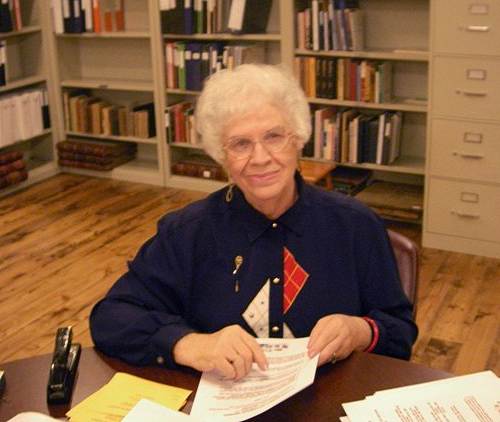
01 Peggy Hake
Peggy has written several books about Miller County historical subjects and numerous articles for the local newspapers over the last thirty five years. She still has a weekly genealogical column for the Autogram where she publishes results of her ongoing research. A major part of our website includes biographical historical narratives written by Peggy which you can read on our website on the Window to the Past page.
But still we have only uploaded a small portion of everything Peggy has written. Some of the articles she has written are longer having been published in the local paper over a period of weeks. Because my part of the website doesn’t have any particular restriction as to length or subject I am endeavoring to place Peggy’s lengthier research articles here. This week I am uploading Peggy’s historical article about the Iberia Academy, first published in the New Iberian in 1981 and later in a book. The Iberia Academy was one of the most exceptional educational facilities to be found either locally or, in fact, about anywhere in Missouri during the time it was in operation. Its story is a fascinating account of the unlikely coincidences which brought to our county G. Byron Smith (photo 02) of Illinois, who was a teacher gifted with exceptional motivation, unselfishness, and teaching skills.
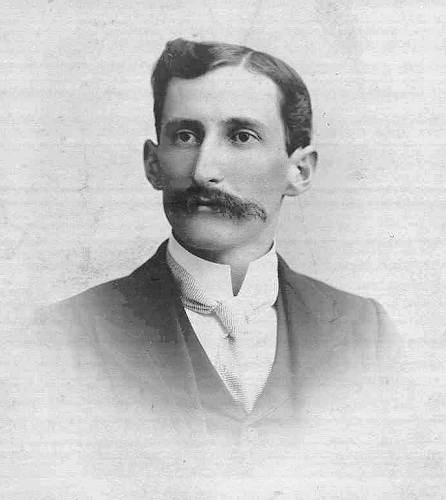
02 George Byron Smith - Iberia Academy
He had the vision and the dynamic personality to bring to Iberia a private school which offered our Miller County students of deprived means the opportunity to acquire an education they otherwise could never dream of having. That he happened to come to Miller County is one of those serendipitous unlikely events in life and history but which have momentous consequences. In the case of Dr. Smith, it would be impossible to estimate accurately how far and wide his influence affected not just our county but the entire country through the students he taught who left here and achieved success throughout the nation.
We have already on our website an abbreviated version of Peggy’s narrative about the Iberia Academy (which has some great photos) which you can view at the Iberia Academy page.
Now for the entire narrative first published in the New Iberian:
History of the Iberia Academy
Peggy Hake
New Iberian 1981
The date was April 23, 1891 and the Articles of Agreement stated, “We, the undersigned citizens of Missouri, residing in Miller County, being desirous of forming a corporation to be known as Iberia Academy do formulate the following as our Articles of Agreement, in words following, to wit: and including therein the names of our President, Secretary and Treasurer and the names of all our members: Marcus W. Fancher, G. Byron Smith, C.W. Farnham, Mary C. Wagner, Mrs. M.C. Hume, George Johnston, Mrs. G. Byron Smith, R. Tom Tallman, Henry McDale, Zella Johnston, L.J. Timmons, Mary F. Jacobs, Henry R. Hoover, Mary L. Tallman, Maggie L. Timmons, Mary Jones, Maggie McDale, W.W. Pearce, Laura Johnston, Lucy A. Fancher, M.J. Stickney and Zepporah Timmons.”
Article One…The name of this institution shall be called Iberia Academy…and thus began the saga of this wonderful old school often referred to simply as Iberia…
But our story really began two years prior in 1889 in Galesburg, a small college town in Illinois, the home of Knox College. George Byron Smith and Miss Mabel White (photo 03) were members of the Senior Class of Knox College in 1889.
.jpg)
03 Mrs. G. Byron Smith (Mabel)
He was a native of Princeton, Illinois born there on June 7, 1865, the son of Mr. and Mrs. Samuel J. Smith. He graduated from Princeton High School in 1884. Mabel White was from a small community of Macomb, Kansas. The fact that I have stated Mabel White was a native of Macomb, Kansas may cause some comment because in most of the material I have gathered, it is stated that she was a native of the state of Illinois. I got my information from the official list of the members of the Knox Senior Class of 1889 and their respective home towns. Mabel’s was listed as Macomb, Kansas. Their Senior Class numbered thirty two students although one of the members, M. Newton Hurd, died before his graduation day. The majority of the students were native Illinoisans with the exception of four who represented the state of Texas, Minnesota and Kansas. When I contacted the school’s archivist librarian, Lynn Metz, he sent me a wonderful assortment of comprehensive information pertaining to G. Byron and Mabel White Smith’s senior days at Knox. I caught a fleeting glimpse of the personalities of Professor and Mrs. Smith as young folk in their college years and I saw them through a different mirror reflecting an unusual contrast of image than most of their former students will remember today.
G. Byron was a member of the Adelphi Literary Society in his senior year and Mabel was a member of the L.M.I. Society where she served as Second Critic the first term of her senior year. Both G. Byron and Mabel were active members of the Y.M.C.A. and the Y.W.C.A. on campus. Mabel served as Vice President of the Y.W.C.A. in her senior year. This religious association was a joint organization at Knox until 1884 and in that year they emerged as separate institutions.
Professor Smith was always a small man in stature. His senior year, when he was twenty four years of age, he stood five feet, seven inches tall and weighed 140 pounds. His religion was Congregationalist, his politics, the Prohibition Party, (which at that time had a very small assembly of members). The most interesting thing I learned in the statistics polled through his Senior Class was that he left the space blank that referred to his hopes for a future occupation. When he was asked to speak the thoughts of others that would reflect his own thoughts, he chose the following quotation…”Not stepping o’er the bounds of modesty.” Perhaps he had great expectations for his future in the world of education, but did not want to express them too freely…therefore he would “not be stepping o’er the bounds of modesty” in his future dreams.
I got a beautiful image of their life at that time when G. Byron was asked to express his favorite song and lo and behold! When I turned the page, the song he had chosen was entitled “Bonnie Mabel.” At this time, I believe he was contemplating marriage because in another passage he quoted in the school’s yearbook called “The Gale” this particular passage of literature…”Oh! Fie, upon this single life, forego it!”
So you see, I feel that since I studied these youthful phases in the lives of G. Byron and Mabel Smith, I feel I know them much better and I can continue to write their marvelous story because the Iberia Academy is definitely just that…Their Story!
2
Two trains play a major role in their story. The first one Professor Smith took and the other one he missed! Just a few days after graduation from Knox College, G. Byron found himself on a crowded railway car heading westward and somewhere along the way, a good natured drummer (traveling salesman) sat down in the seat next to him. They struck up a conversation and when the drummer learned that G. Byron was a newly graduated college man, he asked him a very profound question, “Now you got it, whatcha goin’ to do with it?” His answer was simply that he really didn’t know at that time and he went on and related his story to the drummer. Let me quote to you a few of the things he had on his heart that day. He said, “I don’t want you to think I’m a fool, but sometimes it seems to me as though I have been born too late. It seems as if all the really worthwhile things in the world have been done and nothing left for us young fellows to do but beat the same old paths and do the same old things that our fathers did. I envy the fellows who lived a hundred years ago for they had a wilderness to conquer and unknown lands to explore and a chance to work among people who had nothing.” When he spoke this last sentence, the drummer perked up and said to him, “Sir, I get it, you’re achin’ for a place where folks ain’t got nothin’ and don’t know nothin’: am I right? Well young man, I guess you ain’t never heard of a place called Iberia, Mizoury!”
The drummer informed him that the little village of Iberia was situated at the foot of the Ozark Mountains. He told him to catch a train to Crocker and then drive twelve miles north over the Ozark foothills and at the end of those twelve miles of the worst road he would ever again see, he would find “some little cabins, some women smokin’ corn cob pipes and some grown men playin’ marbles to help ‘em forgit they’re alive. And son, when you reach that place, you’ll know you have hit Iberia.”
After staying in St. Louis for two weeks, Professor and Mrs. Smith set out on a night train arriving at the Crocker station in the early hours of morning. They were met at the train by an Iberia preacher and they all set out on a tiresome drive across what seemed a thousand hills until at last they came to a halt on the crest of a hillside and looked over into a beautiful valley with the town of Iberia sprawled here and there across the center of the valley.
Professor Smith was informed about a school that was standing empty in the town. The poor school had been kicked around from “front fence to back gate” and one teacher after another had drifted in, taught awhile, but were soon gone. The school had no other destiny but failure and when it closed there wasn’t another accredited high school in southern Missouri within a 20 county radius. The people of Iberia had the potential but not the opportunity to prove their capabilities for it was said of our Miller County folk, “they are the purest blooded Americans in the United States. You never saw more splendid people. Rub your hands across them only half a dozen times and you are astounded at the ease with which they take on polish. But there was no one to give them those half a dozen rubs.” (taken from an article in the American Magazine in the year 1916).
Iberia had a reputation in those years of being the toughest town in the mountains and the men seemed to be proud and boastful of this reputation. A question was once asked of them: “Why do you fight? What is the use of it anyway?” The answer: “They fought for the same reason they married early and for the same reason they played marbles…they simply had nothing else to do. Suppose there was nothing, absolutely nothing to do or to look forward to but monotony, boredom and more boredom, well, you would fight.”
Needless to say, this young man and his wife from the civilized world of a college town certainly had their work cut out for them in this new life among these backwoods, mountain people.
3
The Normal School was a five room building with only one room completed for use. In October of 1890, it had a $1000.00 mortgage against it when Professor Smith decided he could make the academy a success. His first year he managed to finance the school, primarily from his own meager funds. There was only one pupil capable of taking academy work that year with 15 or 20 students at the elementary level of education, but that one pupil was given the full academic course. This first year the Smith’s lived in Iberia was one of the happiest of their lives for they realized that these children of the hills were starved for a proper education and absorbed so thoroughly everything taught them. But in June of 1891, the world crashed and tumbled around Professor and Mrs. Smith. Some local business men of Iberia who held the $1000.00 indebtedness against the Normal School walked through his doorway and informed him they had some fantastic news: “They were going to sell the school building because they had received an offer they couldn’t refuse and it would be used for a livery stable in the future!” This was a devastating blow to Professor Smith and he could not reason with the business men for they had waited for years to get their money back which had been invested in what seemed a “bad venture.”
A few days later he had the heartbreaking task of informing his students that the school would no longer be in existence and that he and Mrs. Smith would be returning to their home in Illinois. One child had walked barefoot thirty miles to enter this school and he cried, “Perfessor, you told me you would git me fit fer college” and other children voiced the same opinion, begging “please don’t go!” I can almost feel the agony he must have felt at such a pitiful plea when he knew there was nothing he could do to prevent the school’s closing.
And now I will tell you about the second train in the life of the Smith’s…the one they missed!
When G. Byron and Mabel left Iberia that June day with their horses and carriage, they traveled southward heading toward the railway station at Crocker for they had a train to catch. But fate intervened in the form of Mother Nature…overnight the Tavern Creek had flooded and when they arrived on the north bank they could not ford the creek anywhere. They were stranded there for a long time and when they finally were successful in crossing the Tavern, they hurried full speed into Crocker, but their train was gone and on its way to St. Louis.
They waited for twelve hours before they could catch another train which would take them into St. Louis. On board the train at last, Professor Smith could not rest because he was haunted by the sea of children’s faces pleading silently to him. Sitting across the aisle from him was a man who as to play a very important role in the story of the Iberia Academy. He engaged in a conversation with G. Byron and after a hundred miles of listening to a story about a crude log cabin bursting with eager faced children pleading for the chance to have a proper opportunity to get some “book learnin”, he made a decision that changed the course of Iberia’s history. The man was William Jones, a St. Louis attorney who told Professor Smith that he must return to Iberia. He said that he would put up $500.00 himself and the old “hardshells” of Iberia could put up the other $500.00 needed.
You know the rest of the story…Professor and Mrs. Smith did indeed return to Iberia and remained for over fifty years at their Academy.
4
The academy was started on faith…a one man idea. For years its struggle for existence was keen. Its buildings were few and poor; its equipment most meager; its methods were looked upon with distrust. Finally, it won out, its work was approved and it ranked among the best high schools in the state. It was sometimes spoken of by President Hill of the State University as the “Mother of High Schools of south central Missouri. This Academy has shown herself to be a factor in molding the educational opinions of the state and this through boys and girls of the Ozark Mountain type.”
These foregoing words were spoken by Mrs. Smith in 1929 and they show so eloquently that the school had been a success in the 38 years that she and Professor Smith had been there, so I will return to the beginning once again and show you that their early years were difficult at times but so rewarding.
On October 1 1890, the first term of the school began with Professor and Mrs. Smith its only teachers. He taught Natural Sciences, Languages, and Higher Mathematics. Mrs. Smith taught Literature, History and Civics. The school had no library and very few items pertaining to scientific apparatus. The school yard was small, approximately one acre and was unfenced. The Academy had only one student that first year…. Miss Stella Moore, daughter of Dr. John H. Moore of Iberia. At the beginning, the Academy offered a three year course with each year divided into three terms of twelve weeks each. Later this was extended to a four year course with two types of courses offered…the Latin Scientific and the English version. By 1907, five courses were given instead of the original two which included the Classical, the Normal course and the Business course.
At first, no music classes were available to the student, but by 1907, a department of Music had been established equipped with three pianos, an organ, and a cello. Special instruction was given in piano, harmony, analysis, counterpoint, and Musical History. Every year two musical recitals were presented in which the music students took part. On November 13, 1896, the following program was presented: Piano solos were given by: E. Florence Bittle, Ella Mace, Maude Benage, Annie Johnston, Fanny Mace, Ophilia Harper, Eugenia Brown, and Mrs. H. M. Garner. Special songs were presented by James Bond, Mr. McCubbin, Mr. Groves, Mr. Benage, A. Bertha Cushing, Sallie Johnston, and a recitation was delivered by Frank Lombar entitled, “Seein’ Things.” (photos 03a and 03b)
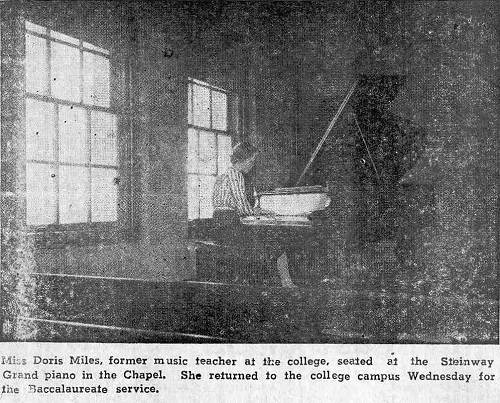
03a Doris Miles - Music Teacher
Click image for larger view
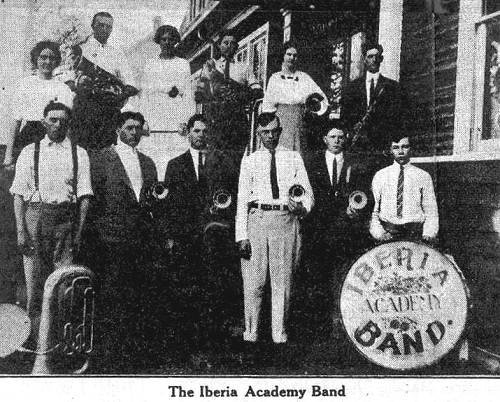
03b Iberia Academy Band
Click image for larger view
The Science Department was started in 1890 and the Department had a few chemical agents and a human skeleton, but by 1907, there were two large laboratories with a substantial inventory of materials for the chemistry, botany, zoology, and physiology classes. They had three compound microscopes, dissecting microscopes, and necessary instruments. There was a herbarium of more than 500 plants, an entomological cabinet; an ocean cabinet of specimens; 300 microscopic slides of histology and embryology. They had a projective lantern which could be used for class demonstrations and a reference library of scientific works. I was simply amazed to discover that this early school had such a marvelous collection of scientific and biological materials and apparatus in the year 1907.
The hill people of the Iberia area were poor folk in the latter portion of the 19th century; therefore low tuition was charged them so that everyone who wanted an education could afford it. The first year (1890), the full term tuition amounted to $6.00 for the Academy and the Common School charged $3.00 for the Primary Department, $4.00 for the Intermediate Department, and $5.00 for the Advanced Department. Board could also be had for $2.00 per week. By 1910, the tuition had increased to 9.00 per year and board was secured at the ladies’ Hall for $1.85 per week or in town for $2.25 weekly. Self boarding students often found rooms for as low as 15 cents per week!
5
As the school grew in size, there came the need for an inexpensive boarding house, especially for the girl students. The Alumni Association undertook the project of building a dormitory on campus and they were given much support and financial assistance by the citizens of Iberia and its surrounding communities. In 1907, this new three storied building was finished and was christened by Mrs. Stella Moore Gardner, the Academy’s first graduate (class of 1893). Professor Smith delivered a short address that day, followed by a special address by Dr. John L. Benage (Class of 1895) who was a practicing physician in Lebanon, Mo. Dr. Benage was also the Alumni’s president that year. The name chosen for the girl’s new dormitory was “Alumni Hall” which was constructed at the cost of $10,000.00 (photo 04).
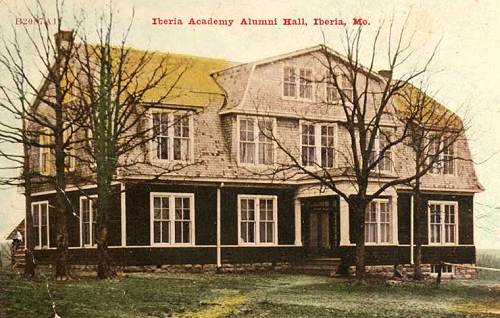
04 Iberia Academy Alumni Hall - 1906
The parlor and music room were used by all the girl students and many young men who roomed in town, took their dinner at Alumni Hall as well.
A second dormitory was also on the campus called “Girl’s Cottage.” It was a six room house used by the girls who wished to board themselves. Mrs. Samuel Smith, Professor Smith’s mother, acted as matron to the residents of the Girl’s Cottage and lived with them. The girls brought their own food from home and used the large kitchen in common. The rooms were comfortable and homelike…one even had a piano in it. The girls living in the cottage had privileges at Alumni Hall and could use the parlor and the music room.
One of the first societies organized at the Academy was called the Atheneum which was a training ground for members to learn to debate. It was later called the Academy Debating Society. In 1899, a new Society was formed from the two previous ones and it was called the Philorhetians. They met once weekly and once a year, a medal was presented to the best debater as a prize. In 1901, the officers of the Philorhetian Society were: Frank Lombar, President (photo 05); George Duncan, Vice President; James Findley, Secretary; and Everett Fancher, Treasurer. Other members included Arthur Alexander, Hugh Atwell, Zeb Bear, Elmer Barton, Charles Brown, Clifford Clark, H.M. Garner, Frank Howell, Willie Jones, Barnard Jackson and Walker Jackson.
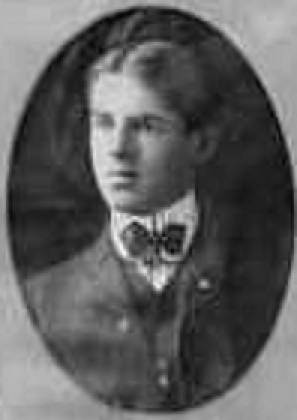
05 Frank D. Lombar
The Pilorhetorian’s published two papers during their existence first called “The Index” and later called “The Cad.”
The young ladies of the Academy had a Literary Society which they called Asteres. Their primary aim was to cultivate ease in speaking. Frequently they held joint sessions with the Philorhetians Society. The ladies of the Asteres Society apparently assisted the men in editing their paper called “The Index” for in 1903 the staff members named were: Hugh Murphy, Jr., the editor; Maude Benage, the assistant editor; Charlie Brown, the Literary associate; Clifford Clark, Athletics Department; Rosa Fancher, Alumni department; Edith Irwin in charge of the YWCA and the YMCA; and Frank Lombar, the manager.
There were religious societies on campus as well as the literary ones. A young Men’s Christian Association was organized in 1895 and later the ladies organized their religious society called the YWCA. Chapel services were held every school morning and all students were required to attend (photo 06).
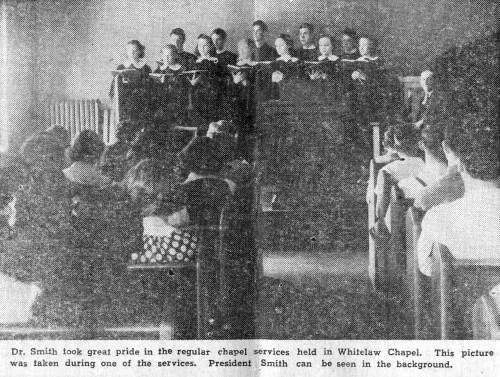
06 Church Services
Click image for larger view
For many years Academy prayer meeting were held on Saturday nights to which all students were invited. For a number of years, an Iberia delegate was sent to the summer conference of the YMCA held every year at Lake Geneva, Wisconsin. In 1904, George Duncan was the delegate and in 1906, the Iberia representative was John Sherrick who was the Y’s President. The girls also attended these summer meetings at Lake Geneva and in 1901, Miss Olive Bear received the honor; Gertrude Wright was chosen in 1902. In 1904 Edith Irwin attended, and in 1906, Myrtle Irwin and Lou Bond were chosen to attend the Waterloo, Iowa conference.
6
The Academy not only stressed the importance of mental training, but also the physical. Early in its existence, a fine athletic program was instigated and the principal games played were baseball, football and tennis. In 1901, the boys and the girls each had an Athletic Association. The officers of these two organizations included: Frank Lombar, President; Hugh McCoin Garner, Vice President; Clifford Clark, Secretary; and Otis Wright (photo 06a), Treasurer.
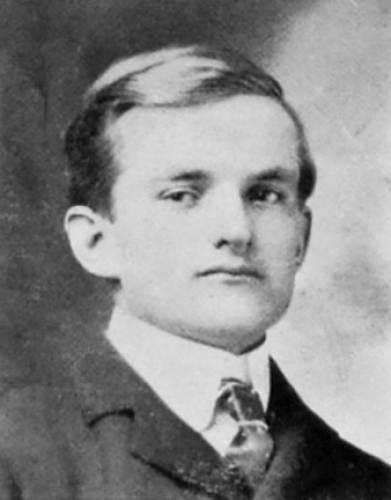
06a Otis W. Wright
The girl’s Association officers included Beth Laughlin, President; Mary Howell, Vice President; Miss Morgan (a teacher), referee; Sarah Shelton, Captain and Gertie Wright, Captain. They had rules for their athletes in those days that had to be strictly obeyed including perfect class attendance; no one would receive any pay for their services on the teams; could only participate in any contest with the permission of the Faculty Committee on Athletics, etc. Every year at the climax of the athletic program, the School had a Field Day where the students could participate in running, jumping, and pole vaulting events. They produced some fine athletics over the years.
Commencement time was a busy time for the School. There were so many events scheduled for such a short period of time. A typical week of commencement began with examinations, followed by Musical Recitals; an Academy Picnic; Children’s Day exercises held at the Congregational Church; a Baccalaureate sermon; Field day activities; a musical reception and exhibition; Commencement Night, followed by a message to members; and a Prize Speaking contest where the winner received a five dollar gold piece. The Baccalaureate and Commencement services and also the receptions were held in the Academy’s Chapel.
The following are a few participants of the Prize Speaking Contest I mentioned above:
In 1894: Genie Brown, O.M. Waite, Elbert Barnes, Herbert Hays, Mabel Armistead, Fred Benage, Stephen Timmons, Otto Benage and Drusa Allen.
In 1898: Perry C. Burks, Mary Nelson, George Bear, Isabella Ferguson, J. Frank Johnson, Olive Bear, Wendell Phillips and Lillian Prock.
In 1899: Margaret Shackleford, Frank Fike, Delia Hays, G. Bernard Jackson, Emma Garner, and Belle Ferguson.
In 1900: Beth Laughlin, Logan Allee, Cora Wickam, Sarah Shelton, and Frank Howell.
In 1905: Ralph Wickam, Walter Smith, John Sherrick, John bear, Edith Irwin, William F. Jones, and Effie May Sherrick.
The school had its own newspaper published in the interests of the students called “The Academy Student” which coincided with the other two papers: The Index and The ‘Cad, printed by the Literary societies. In 1899, The Academy Student was edited by Ms. Cora Wickham and she was assisted by Frank Howell. In 1900, the editing duties belonged to Ms. Beth Laughlin assisted by Sarah Shelton (Isn’t it interesting to note that at the turn of the century, the girls were heading up the staff duties of the School’s paper?)
7
I am reprinting some excerpts from this paper in the early years of the 1900’s and I know you will find them interesting:
January 1, 1900:
“Professor and Mrs. Smith entertained the Senior Class with a Thanksgiving dinner. We draw the conclusion from what we hear that Mrs. Smith knows how to cook!”
“Some of the boys are getting quite skilled in stonemasonry as well as football.”
“The self boarding boys of one house invited Miss Tooker (a teacher) and the other self boarding students to their home on the last Saturday night of the term to a peanut cracking. After eating all the peanuts we could, we had a good social time until ten o’clock when we thanked the boys for their kindness and returned home.” (Friends, I believe our young people in today’s world should learn a few of these old customs such as peanut cracking, whatever on earth it was!)
April 1, 1900:
“Work upon the stone of our new building is progressing nicely…a gang of ten to fifteen boys work two hours each evening after school and fifteen to twenty all day Monday…the stone is ours for the asking and the boys are ready, willing and glad to work.” (I believe they were constructing two extra rooms onto the original Normal School building that was standing but not in use in 1889 when Professor and Mrs. Smith first arrived in Iberia.)
July 1, 1900:
“The two string bands were much appreciated during Commencement week. There were eight in the ladies’ band and seven in the boys’ band.”
October 11, 1900:
“There are about 25 self boarding students already and more are expected. Miss Tooker has charge of the girl’s home and is proving herself most capable and popular.”
8
June 15, 1902:
“The students, as usual, went fishing May first.” (This was an annual event held on May Day when the teachers and the students ventured out to the Big Tavern Creek and spent the day fishing, picnicking and strolling along the creek bank.)
June 15, 1901:
“The moonlight orchestra has been doing some splendid work on the Post Office porch the past two weeks.”
1907:
The “Cad,” “Who put the bell under study hall?” (This refers to an episode which occurred that year and was planned and carried out by a group of “future inventors”. A rope was fastened to a bell under the study hall and it was brought up through a small opening in the floor. It was easily operated by a student who was sitting very innocently and nonchalantly in the room!!).
Prizes and scholarships were awarded almost from the beginning of the school. A $50.00 scholarship was awarded each year to the student having the highest average. Knox College in Galesburg, Illinois, offered a $50.00 yearly and the winner of this one was left to the judgment of the Academy’s faculty. Every year a five dollar gold piece was awarded for excellence in declaration and a gold medal was given at the annual Debate. In 1900, the winner of the Drury scholarship was Perry Burks; the five dollar gold piece was awarded to Cora Wickham and the second prize in that category was a set of books awarded to Della Hays. A certificate of Admission to the freshman class of State University was awarded to Logan Allee (photo 07), who later became a Miller County physician in the Eldon vicinity.
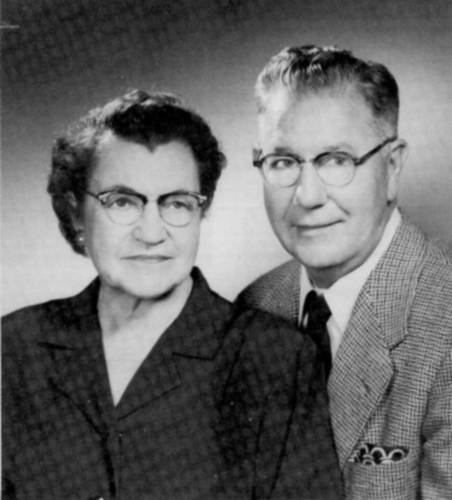
07 W.L. Allee and Maude Franklin Allee - 1952
Professor and Mrs. Smith first lived in a house on the corner across from the school. The house is still there today known as the “Fatty George Mace” home (photo 07a).
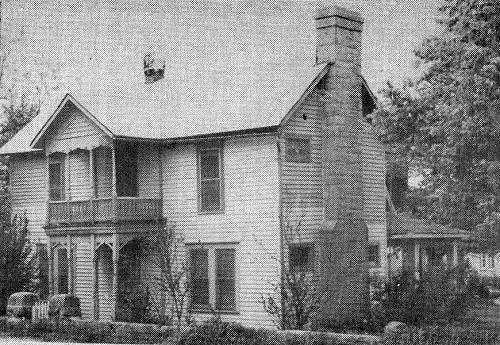
07a Iberia Academy - Home of the Smiths
9
I have been told that the young “roughnecks” of Iberia gave them a difficult time when they first settled here. It seems that they loved to play tricks on Professor because he was what they considered “citified and educated and we were just plain country folks and old timers.” Sometimes overnight, a few late adventurers would slip out to where he kept his buggy or hack parked and would switch all the wheels on it! But over the years, as the Iberians came to know them, these pranks were stopped and all who knew them came to deeply respect and admire them for their spirit and courage.
The decade of 1910-20 saw a new growth in the school due to Professor and Mrs. Smith’s untiring efforts. Their dreams were becoming a reality and this gave them the initiative to strive harder and set new goals for the school.
Approximately in the year 1906, Harriett Smith, known to all as “Mother Smith,” the widowed mother of G. Byron, came to Iberia to live with her son and his wife (photo 08).
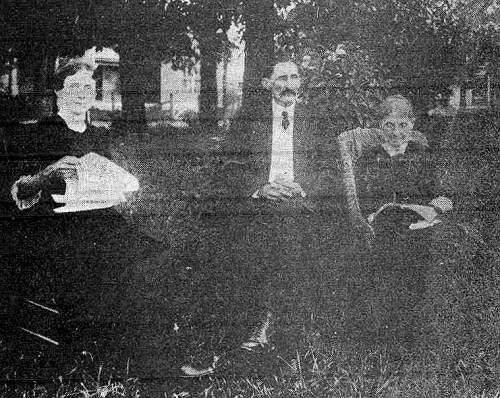
08 Professor G. Byron Smith - His Wife and Mother
“Mother Smith” was a native of Ohio and lived there until shortly after her marriage to Samuel Smith. As a young married couple, they emigrated to the state of Illinois, sometime during the Civil War years. They settled down in Princeton, one of the early colonized New England settlements of that western state. Her two children were born in Princeton, George Byron in 1865 and a daughter, Clara, who died as a young girl. She was a great influence in G. Byron’s formative years, persuading him to choose Knox College. When she came to Iberia in 1906, she became a familiar sight on campus. She did not sit down in her proverbial rocking chair and peacefully let her life slip by. She took a great interest in Iberia Academy and its students. She had a child like faith and an unbreakable will to see that her son’s dream would succeed and she threw herself into this work wholeheartedly. There was a time the school needed an additional cow to furnish milk for the kitchens, but could not afford to buy one. Mother Smith purchased the animal out of her own funds and presented it to the school. Her most generous gift of all is still standing at the school’s entrance, “The Gateway of Opportunity” (photo 09) constructed of stone and this entrance way has seen many, many young men and women come through it gates and emerge prepared for the opportunities the world had to offer them.
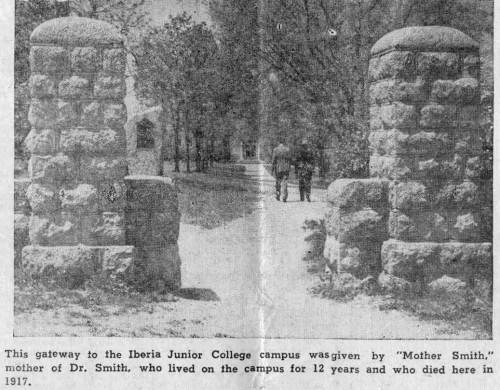
09 Gateway to Junior College
Click image for larger view
She saved the money for the construction of this “Gateway” by taking the kitchen and dining room work into her own hands for a term. There was a time when she loaned a sum of money to the school when it faced financial problems and she was not a wealthy woman; she had only a “slender capital.” She was willing to sacrifice what she possessed in order to see the Academy become a self sustaining school.
Mother Harriett Smith died of apoplexy on Saturday, July 23, 1917 at the home of her son on the Academy’s campus. She had lived here in Iberia for eleven years and she became a great influence to many lives whom she touched. A funeral service was held on campus in the midst of her family, pupils, alumni and friends of the Academy. A second service was held in Princeton, Illinois in the chapel of the First Congregational Church where she had been a devoted member for over fifty years. Both services, at Iberia and Princeton, were conducted by her old friend and pastor, Reverend A.H. Armstrong.
10
By 1912-1913, the Academy and campus encompassed twenty acres, including an athletic field and three good buildings. The Academy building contained five recitation rooms, a chapel, a library, and two laboratories. Alumni Hall (photo 10), the girls’ dormitory, was a well built three story building which contained a parlor, music room, dining room, kitchen, china closet, and three rooms for Professor and Mrs. Smith on the first floor; the second and third floors were dormitory rooms used by the young ladies and the female teachers.
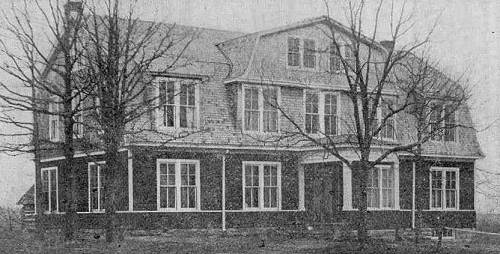
10 Alumni Hall
Professor and Mrs. Smith had a telephone in their quarters and it was used by all students in the Hall. The third building on campus was a two story cottage which was the home for the girls who could board themselves. Mrs. Smith, the Professor’s mother, lived with the girls in the cottage. They had a kitchen area with a good range that all the girls shared. The Alumni Hall had a furnace, but the cottage was heated with ordinary wood heating stoves.
The library had an inventory of over 7000 well selected and catalogued volumes. It also had a reading room where many of the best periodicals and newspapers were stored and was opened daily for the use of the students (photo 11).
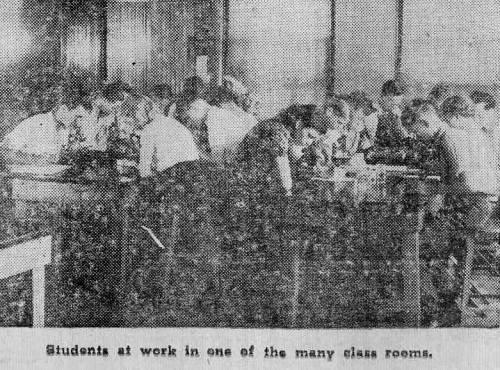
11 Students Studying
Click image for larger view
The year’s tuition, various fees, board, and miscellaneous expenses averaged the student approximately $140.00 total expenses yearly in the time era of 1912-15. But lack of funds did not deprive anyone of an education who was willing to work. Professor and Mrs. Smith helped each student who could not meet expenses by letting the child work his way through his education. There were various means of obtaining this including work in the library, binding books, household chores in the dorms, summer work for the citizens of Iberia and jobs in the fields, etc. One former student told me she worked her way through the Academy in the time era of 1917-19 laboring in the summer months for 7 ½ cents per hour and when she received a raise to 10 cents per hour she was thrilled beyond words!
(Note: here is a series of photos of student activities: 12, 13, 14, 15, 15a, 15b, 15c 15d)
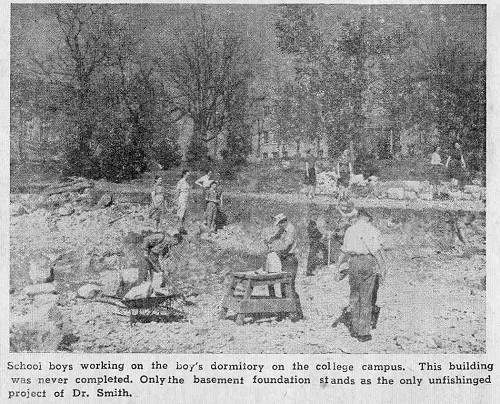
12 School Boys Working
Click image for larger view
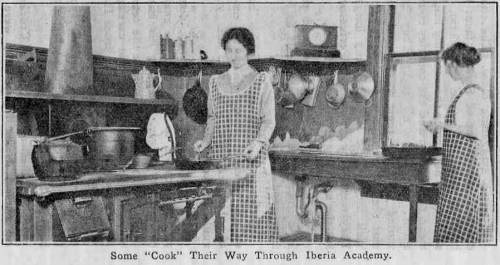
13 Students in Kitchen
Click image for larger view
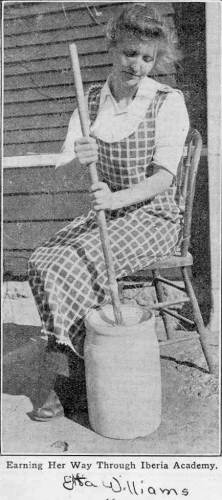
14 Lisa Williams
Click image for larger view
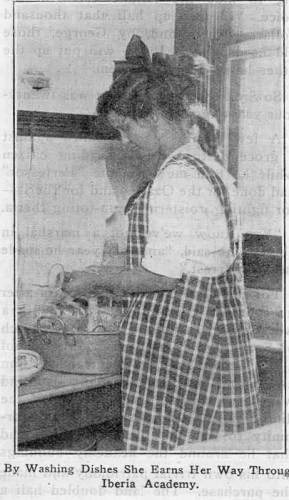
15 Kitchen Duty
Click image for larger view
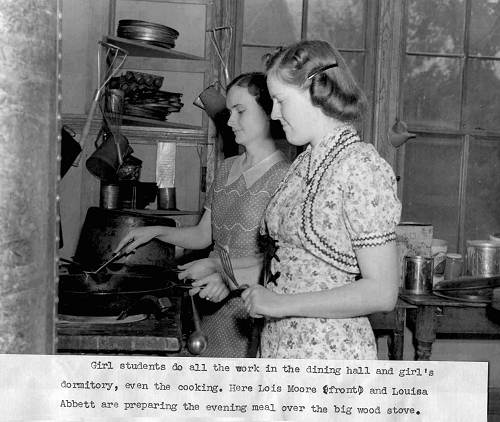
15a Academy Students Lois Moore and Louisa Abbett
Click image for larger view
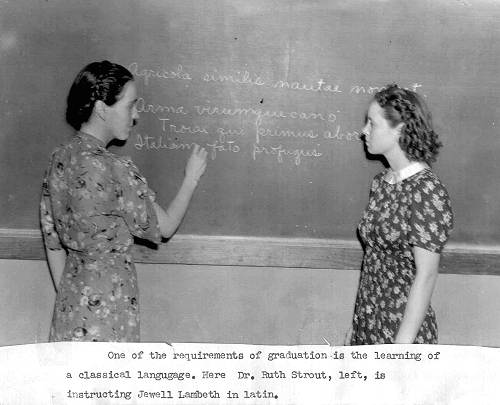
15b Dr. Ruth Strout and Jewell Lambeth
Click image for larger view
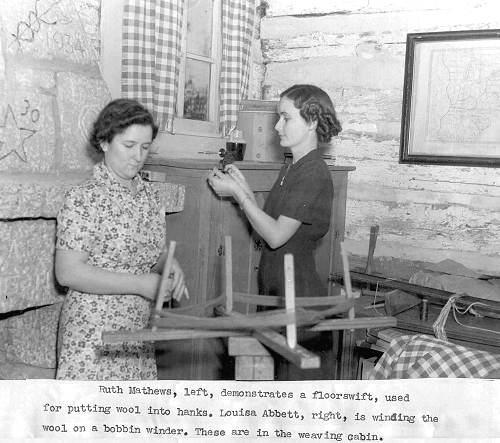
15c Academy Students Ruth Mathews and Louisa Abbett
Click image for larger view
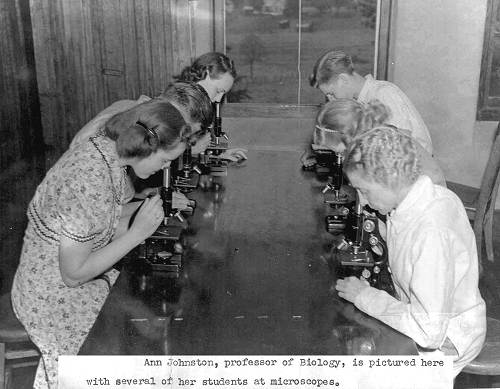
15d Academy Students with Professor Ann Johnston
Click image for larger view
Some of the early subjects taught in the school included Ancient History, Rhetoric, English, Math and Algebra, Agricultural Science, Biology, Geometry, English Literature, Botany, Zoology, Chemistry, American History, German grammar and Literature, Greek Grammar including Xenophon and Homer, and Latin Grammar including Virgil, Cicero and Caesar.
At the beginning of the second semester, a five week Agricultural course was offered to the local farmers and their sons and daughters. The latest method of scientific farming was studied and was taught by highly qualified men who were sent by the Missouri Department of Agriculture. Over 200 were enrolled in the first class offered with an attendance averaging well over 1000 persons over the five week period.
Demerit marks were given to any student who persisted in class absences, tardiness or misconduct. When one had received a certain amount of these demerits, he was required to report for work on Saturday morning at the Academy building and had to spend the entire morning at whatever was assigned to him. For misconduct often times a student was placed under censure. While he was under censure, he could not receive financial aid from the Academy; was barred from social activities; forbidden to participate in the prize contest; and could not publicly represent the school in any way on a public program or athletic field. These may seem harsh punishments by today’s standards, but they were strictly enforced and apparently they worked! There were other rules set down that were also enforced and would probably be ridiculed and disobeyed by today’s youth…one in particular was that all students were required to keep study hours and all who boarded in town were required to be in their rooms after 7 p.m. on study nights!
In 1913, the Ladies’ Aid Society of the First Congregational Church of St. Louis presented the Academy with a Star Grand Piano. These ladies were great friends of this old school and through their efforts and generosity, the campus Chapel was presented this beautiful instrument where it was used for recitals and other entertainment and was a great help to the entire school.
11
The same year a fund raising project was begun to pay off the debt on the property. They proposed to raise $5000.00 and with this amount, they would pay off the outstanding debt; buy some new equipment; have the buildings painted; put in new concrete walks; put electric lights in all the buildings; put new desks and office equipment in some rooms; buy some needed apparatus for the science department and whatever else was needed to put the school in a first class condition. Can you believe they proposed to do all that with a $5000.00 project? Today, we would be using a six figure number!
Professor Smith made a trip to St. Louis and spent months raising the $5000.00 and he was successful in his efforts when he brought back $5200.00. It took him almost two years to raise that figure, but his persistence paid off and the fruits of his labor began to be seen. The entire population of Iberia and vicinity were so proud of him for his work in the community and on the Sunday night after his return from St. Louis it was proven. Almost the entire population of Iberia formed a torch light procession: they marched to Alumni Hall; loaded Professor into a buggy drawn by an enthusiastic group of boys followed by a hundred torch bearers, automobiles, and hundreds of excited citizens, marched down Lombar Avenue and halted in front of the Modern Woodmen of America Hall and he was called on to make a speech. He was so overcome with such a triumphant demonstration, but he did make a marvelous speech to the townsfolk. At the close of this exciting, evening, the town’s band played one of Professor Smith’s favorite pieces of music.
In 1914, the school had very modern equipment including Remington and Underwood typewriters, a mimeograph machine; office equipment of vertical letter files; card cabinets and other supplies in the Business Department. The Business teacher that year was Mrs. L.S. Diven who had had thirteen years of experience in that particular field and she was considered one of the very best and qualified to prepare the Iberia students for good positions in the business world.
In 1914, the music teacher was Miss Myrtle Hoyer, a graduate of the Knox Conservatory of Music. She was very popular on campus and she organized a music club that year which met every two weeks. The orchestra was also very popular. Iberia was considered as having one of the best accredited Music Departments in the South Central Missouri area. They had a brass band, and orchestra, a musician’s club and a chorus. As early as 1900, they also had acquired a violin teacher.
In 1913, the Academy had a great football team, but it only played two games that year! The first was held on October 18 at Iberia with the Rolla High School. Can you believe that the score was 78 to 0 in favor of Iberia? The second game was scheduled on Thanksgiving Day with the same team, but was to be played in Rolla. When it came time for the game, the Rolla team “desired” that the boys play the School of Mines instead. (It sounds as though our boys had placed “dreaded fear” in the Rolla team!). The Miners were made up of men of more experience and they had eleven substitutes which they kept sending in throughout the entire game, while Iberia’s first eleven played the whole game! Rolla beat them 20 to 6 but I think it was fantastic that the Iberia’s defensive team kept the score so low considering their odds. The Rolla newspaper, “The Rolla New Era,” said of our Iberia boys: “they have a Number One team, all the men playing their positions like stars of the larger and stronger teams.”
With the school free of debt, its value of 1917 was placed at $35,000.000. From one student taking high school work in 1891, the number had increased to almost 100 students in 1917. In the twenty six years since its beginning, the school had graduated 114 high school students and 76 of this number had gone on to college with 56 graduated or still attending a college in that year (33 at Drury, 19 at Knox, and 11 at State University). Needless to say, Iberia had certainly changed in those twenty six years. She had progressed from an “Ozark Mountain hill town” called Iberia, Mizoury to a town that had seen a new era arise out of the old customs of the mountains and their children were receiving all the”book learnin” that their hearts desired.
12
The Academy was in a great shape in 1917; their debts were paid; the buildings were among the best in the country. School had begun in the Fall of 1917 with many spirited students prepared for the new school year. On October 30, (some reports say October 29) a great calamity occurred. A great fire destroyed the main Academy building. For awhile the fire threatened to spread to the other buildings on campus, but men were stationed on the roofs of these other buildings and kept the structures saturated with wet quilts and buckets of water. Mother Nature once again intervened on behalf of Iberia Academy when she deluged the area with frozen rain and snow. I believe that had not the heaven sent rain and snow fallen, the entire campus would have perished for there was not the necessary equipment available in those years to hold back a raging inferno. For even in 1939, much of Iberia’s downtown area was destroyed by a great fire and could not be held back or controlled.
It was thought the fire was started in the Music studio in the southeast corner of the building where a fire was kindled in a stove a short time earlier. A defective flue in the room was probably the origin of the fire. The fire raged out of control very quickly and seeing that the building could not be saved, the citizens and students alike began to try to save some of the furniture and most importantly, the books inside. Through the heroic efforts of many, all the books were saved except about 1000 volumes. But some of these were in a very poor condition for they had to be thrown out the second story window into the mud, ice and rain. The library had a value of $12,000.00 placed on its contents in that year so it suffered some monetary loss. Some of the laboratory equipment, a few chairs, and one of the pianos was all that was saved along with the books, but they were all fire damaged. Professor Smith estimated the loss at $15,000.00 but this could not begin to replace everything lost. There was only $5500.00 insurance on the building and contents…insured with the Central Insurance Company. Despite the heavy loss, Professor Smith once again demonstrated his spunkiness and courage and arranged for a $30,000.00 fireproof building to be designed and built. The week of November 17 through November 28 of 1917 was set aside as the ”Iberia Academy Campaign.” Sunday, the 19th was called “Academy Day” and union services were held at the Woodmen Hall. They had a slogan “something from everybody” that inspired them on. Committees were formed and began a canvass of the town and surrounding communities. Many of the townsfolk were inspired on in this quest and formed eight teams to canvass and solicit funds and pledges. The local schools and churches all joined in the campaign and through this wonderful community effort, the first week they had raised $4,635.00. Wanting the $5,000.00 figure they had set as a goal, they set out again and when they returned they had $5,529.00 in hand. Isn’t that incredible? This $5,529.00 would not build a $30,000.00 fireproof building but it was a good step in that direction.
The alumni raised an additional $1,000.00 and after this was raised, plus the $5,500.00 insurance, the people of Iberia had over $12,000.00 to put into this new school building. Additional funds were solicited from friends of the school and the St. Louis members of the Board of Trustees and soon there was enough to build the new Iberia Academy (photo 16)!
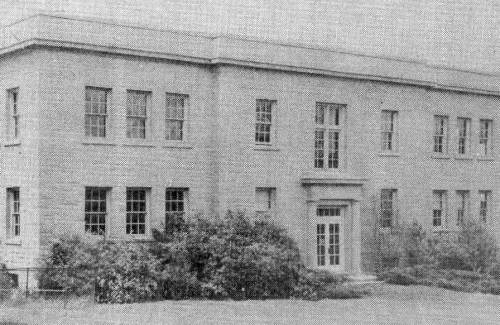
16 New Iberia Academy Classroom Building
In May of 1920, the cornerstone was laid with a special service on campus. Dr. W.T. Nadal, president of Drury College in Springfield, delivered an address followed with a brief talk by Professor Smith. His dreams had not been crushed; his vision of a school for the children of our Miller County area became a reality once again. Mr. Austin E. Fitch, a member of the First Congregational Church of St. Louis, and an architect with the firm of Ferrand and Fitch designed the new school. Mr. P.H. Wall of St. Louis was given the contract to construct the building which was made of native stone quarried from the Academy’s campus. The stonemasons who constructed the building were local men including my grandfather, Frank “Cap” Smith and his brother, Felix “Pea’ Smith. The new two story building contained the James S. Stevenson laboratories; the Oscar L. Whitelaw Chapel; the William E. Jones library; the President’s office and recitation rooms. These rooms were named in honor of men who had played a major role in the Academy’s existence.
13
Iberia Sentinel
March 29, 1912
“The $1000.00 from the Sarah R. sage Estate was received last Monday. This is the first legacy which has fallen to the Academy.”
There were many material and financial gifts given to this Academy and numerous people who were the school’s benefactors in its early days and it was their generous gifts that kept it successful. The names of some of these important people who played such a major role in the school’s existence included: Miss E.C. Ames of Boston; Delos R. Haynes; Attorney William E. Jones of St. Louis; The Congregational Church Educational Society of Boston; the W.H. Danforth family of St. Louis; Oscar L. Whitelaw; the Pilgrim Church of St. Louis; Professor James S. Stevenson of the St. Louis Schools; Wilbur E. Jones, son of William E. Jones of St. Louis; Julius C. Birge of St. Louis; Charles L. Martin of St. Louis; Alice Barber Phlager; Mrs. C.E. Zelle; Dr. Arthur H. Armstrong; Captain F.E. Lombar of Iberia; Dr. A.K. Wray of St. Louis; Philo Stevenson, son of Professor James Stevenson; Ralph T. Whitelaw, son of Oscar W. Whitelaw; Mrs. Eleanor Martin and her daughter Frances of Webster Groves; Mr. and Mrs. Edward F. Jackson of St. Louis; Reverend Russell Stafford of St. Louis; Mrs. Gertrude Kopplin of St. Louis; and many more names that I could print if space permitted.
The Academy had been a school of higher learning for twenty six years in 1916 and it was in that year that a gymnasium building was first proposed. Edmund C. Little, St. Louis Architect, was commissioned to design a new building for the campus. He drew up plans of a gymnasium that would cost approximately $6000.00 to construct. The plans called for a stone building with a balcony on the inside and lockers for the boys and girls at the ends. It was designed to be used as a community center as well as a gym. The main room was to be equipped with a moveable platform and chairs that would seat at least 500 people. In 1916, a fund was started for this proposed building, but it was over ten years late before it became a reality. In 1926, the gymnasium was in use, but it was far from being a completed work. The outside design of the building had a different look than the original one first planned. (Looking at the two architectural designs, I am much more impressed with the gym that we eventually got rather than the original design.)
Commencement exercises were held for the first time in the new building in the Spring of 1926 and in the Fall of that year, it was used for the annual Get Acquainted Social. But at that time, it lacked a permanent roof; concrete steps; doors and windows; a hardwood floor; all inside furnishings and a heating system. Although it lacked many things, it was debt free! About twenty of the Academy boys were working on it at that time without any pay for the funds had dwindled to nothing and the boys did depend on their labor wages to further their education at the Academy. By January of 1927, the approach and the front steps were finished and the roofing material was there and ready to be laid as soon as the weather permitted. It was hoped the building would be finished by the next school term for basket ball games. The work was greatly helped by a generous gift of $250.00 from Edgar H. Bradbury of the Pilgrim Church in St. Louis, given in memory of his wife.
In December of 1927, the Board of Trustees met in St. Louis and decided at that time to go ahead and finish the construction of the gymnasium until the building was completely finished. $1000.00 was subscribed to be used and the balance needed would be raised. So, after it was finished, the building was one of the most beautiful structures in central Missouri. It was built entirely of stone, had a hardwood floor; a gallery on two sides; a stage for dramatics; and it seated one thousand people! It contained a full size basketball court and room for volley ball and indoor baseball. It was erected and named Martin Gymnasium (photo 17) as a memorial to Charles L. Martin of Webster Groves, one of the truest and most faithful friends that the Academy ever had.
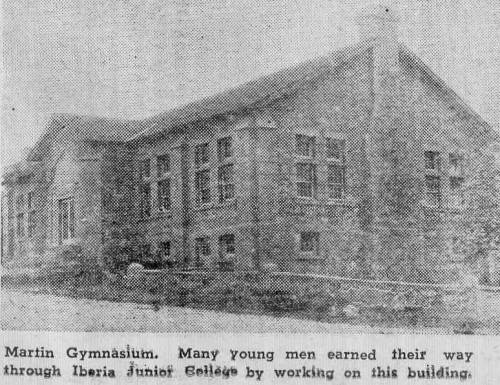
17 Martin Gymnasium
14
From the “Iberia Academy Bulletin” printed in September of 1926…”Iberia Academy and Junior College opened last week with the largest attendance and finest prospects of any year in the history of the school…Every effort has been made to maintain the same high standards in the Junior College and to meet fully the State requirements for an accredited school…It was recognized that the opening day would be historic as the beginning of the first college in South Central Missouri…” And it was indeed a historic day because the Junior College became a very popular school in our Central Missouri region. The year 1926, the school had a faculty of ten including Ms. Virgie Wynn, head of the education Department and a graduate of Berea College in Berea, Kentucky; Ms. Edna Hammack, a Latin teacher, who was born and reared in the Iberia community and was a graduate of Iberia Academy; Gerard Schultz, a graduate of Knox College, the Head of the History Department (photo 18);
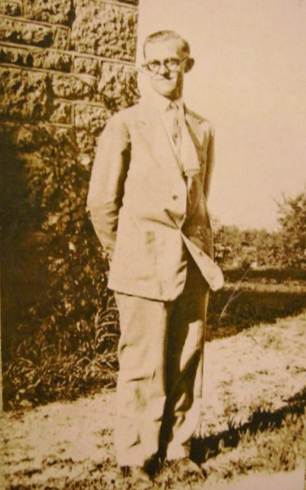
18 Gerard Schultz
Charles R. Brassfield, also a graduate of Berea College and was Coach of Athletics and Dramatics; Ernest Brooks, a graduate of Drury College, headed up the Music Department; his wife, Mrs. Ernest Brooks, also a graduate of Drury College was the instructor in Voice and Theory of Music; JoAnn Spearman, who was Dean of the School, a native Iberian; Ms. Mabel Willis, Dean of Women and Head of the English Department; and Professor and Mrs. Smith who rounded out a very able bodied faculty for the students in 1926. By January of 1927, several courses had been added to the agenda including German, Citizenship, European History, College Algebra, Psychology, and Harmony. These classes compared to the average college courses offered in any other accredited school in the state and it was advanced work that was meeting a real need for the Miller County students as they prepared for their further education in other Universities across the country.
In 1927, a work program was begun that they called “fireside industries.” The original purpose was to furnish labor for the girls who had to work their way through school and at the same time train them to do something useful and beautiful. They were taught weaving in a basement classroom at that time, but due to the interest of Mr. and Mrs. William Danforth of St. Louis, they began remodeling an old log cabin which stood on the campus with funds donated by the Danforth’s (photo 19).
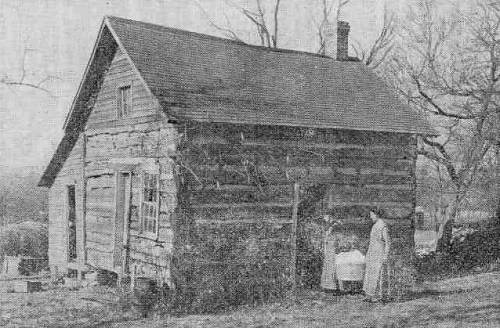
19 Iberia Academy Laundry and Weaving
They had already donated several looms to the classroom that were being used by the girls in their weaving classes. The old log cabin was rich in Miller County history also. It had been the home of a former Negro slave family who had lived in the old cabin in the years before Iberia Academy had been established. There were others in the Schell family who had lived there in the years following the Civil War including Ester Schell and her children. She had acquired 6 acres of land in 1875 and kept it until the year 1892. It was rumored that this Negro family relocated in the Kansas City area where there may be descendants living today. Mr. Austin Fitch, the architect who had designed the new academic building and the Martin Gymnasium, drew up the plans for the reconstruction of the old slave cabin. It was preserved in every possible detail to a pioneer Miller county home. There was a wide open fireplace, looms and a spinning wheel. Rugs for the floor and the curtains at the windows were hand made on the looms and it had the appearance of an authentic pioneer home which it most definitely was! The generosity of Mr. and Mrs. Danforth helped to carry out this project and it was restored to its original state. Unfortunately, the old log house, which was one of the few left in the area, has been torn down. The old fireplace still stands in the original place with a newer home built around it. In 1927, these words were printed in the Academy Bulletin… “log houses are rapidly disappearing from the country and the effort is being made to preserve this historic type of building on the campus for coming generations of students to see and as a memorial to our pioneer fathers to whom we owe so much.”…I am sorry my generation can not see this historical building nor continue to preserve its history!
15
On June 16, 1932, Mabel White Smith died at her home in Iberia. This marvelous team of two dedicated teachers, split by death and sadness, was felt by the many friends and students who had known her. She had been known by forty two classes of students since she and Professor Smith first came to their little school in 1890. Letters poured in from all over the country praising her work and dedication. Many of these letters came from former students who had gone on into the unknown world and made a success of their lives. She left an endowment of $3,000.00 to the Academy and it was her wish that the school would be known as an institution that radiated beauty while at the same time it would develop scholarship and character. She had loved the cultivation of flowers and shrubs and devoted the last years of her life working on the campus’ landscape planting many shrubs and flowers…especially roses. When Highway 17 was built through the backside of the Academy’s campus, it was her determination to have a beautiful back yard encompassing the campus, so her endowment of $3000.00 was used for that purpose. Some of the many fruit trees planted in those years can still be seen on the campus.
Professor Smith continued on in his quest of maintaining a higher school of learning after the death of his wife. The school continued to thrive throughout the 1930’s and the 1940’s producing many graduates who left Iberia and entered other universities across the country to further their education. The War years of the early 1940’s cut into the enrollment of young men, but the school’s faculty and students remained in number through those difficulty years that our nation, as a whole, experienced.
16
In 1945, Professor Smith, who by this time was an aged man, decided to retire after having spent the past 57 years of his life at Iberia. I am sure he wanted to spend every hour possible at his beloved school, but his health by this time was failing, so reluctantly he left Iberia and returned to the home where he had been 80 years before in Princeton, Illinois. Throughout his lifetime, he and Mrs. Smith had taken many tours, visiting numerous countries in the world. At the time of his retirement, these words were spoken of Professor by two old friends of the Academy, William H. Danforth and William J. Hutchins…”Dr. Smith is one of the most modest men we have ever known. He has lived on approximately $1000.00 per year through these fifty years and whenever the Trustees vote to increase his salary, he has demurred. But when the increase is granted, he has given back to the college all over $1000.00. One year, while Mrs. Smith was living, his friends gave him $1000.00 to take a trip to Europe. Traveling second and perhaps third class, and with unusual thrift which taught him how to use funds, the ‘Smith’s made the trip on $500.00 and then went back the second year. We hope that your award might be bestowed on President Smith. His character, and love for his neighbors make him an ideal man for the award.”…after which they gave him the coveted Letter Teaching Award. Earlier in 1918, Knox College had recognized Professor Smith for his outstanding contribution to education and they presented him an honorary doctorate in Science.
(Note: here is photo 19a of the College’s Semicentennial celebration where William Danforth spoke:)
-ProfSmith(middle)_sm.jpg)
19a Iberia Academy Semi Centennial
William Danforth (left) - Professor Smith (middle)
Click image for larger view
The school was converted to an agricultural “Conservation College” in the late 1940’s, but it was a big failure. This plan to change Iberia Academy was deeply opposed by Professor Smith, but a new Board of Directors was chosen and they proceeded on with plans to make the school a “new kind” of college. They emphasized conservation and it was taught in the curriculum and they stated that the time was coming when there would be a great need for such knowledge and practices. It was a good idea, but it did not work in those years. Today, we know only too well how important conservation is needed in our country. Preservation of our natural resources has become a major need in our society. There was a wonderful, full page story printed in the St. Louis Post Dispatch dated September 21, 1948 concerning the Old Iberia Academy Conservation College. A former student of the school gave me her copy of this newspaper article and I learned much as I read this old story.
The last Commencement at the old Academy was held on June 1, 1951. It was the only one in the history of the school that Professor Smith had not attended and only death prevented his presence at this graduation service. On June 15, 1950, eight days after his 85th birthday and almost 18 years to the day after the death of Mrs. Smith, death claimed him at his home in Princeton. Thus ended a life of Christian unselfishness and dedication to the needs of the children of our Iberia community. We owe so much to Professor and Mrs. Smith and their memory should ever be in our hearts.
17
As I bring this history to an end, I want to print something I found in an old magazine article printed by a journalist named Bruce Barton for a national magazine called “American Magazine.” Mr. Barton captioned his story with these words…”You never heard of him….the earth does not tremble where he steps, but he is the “real thing.” He continued on in his interview with Professor Smith and these wonderful words were written of him….”We walked across the campus, Smith and I, one Sunday morning, and I noticed that he stooped a little as he walked. “You’ve been buried here 25 years,” I said. He nodded. “Some of the fellows who were graduated from Knox when you did are rich and famous,” I continued. “Some are bankers, lawyers, some editors, politicians…and nobody ever heard of you. You’re poorer than when you came, and you might have been a college president if you had stayed in the world outside.” We were standing by this time under the goal posts on the athletic field. “Do you think that the game has been worth the candle?”
“Did you ever see a backwoods town with so few unpainted houses as Iberia?” asked Smith. “Did you ever see so many vines trained over porches, or so many flower gardens, or so many people who looked as though they really enjoy the business of living? I wish that you could drive out into the hills for a hundred miles or so in either direction. There are two thousand rude mountain homes around here…as the Bible says…there was no vision, and so the people perished. We’ve taken a boy or girl out of each of those homes. I wish you could have seen them…before and after.”
It was a long speech for Smith! As we picked our way back through the wild flowers, he pointed suddenly at two men, one young, one old, standing together. “That’s the valedictorian of our graduating class, and the fine featured old gentle man with him is his father, one of the most respected farmers in this part of the state.” I noticed he was smiling as though greatly amused and his smile, by the way, is wonderfully rich and tender. “You remember the story I told you about our first night in Iberia, the night when someone broke up the service by throwing a rock through the window of the church? Well, the respected old gentleman whom you see before you is the man who threw the rock!”
As we were jolting back across the twelve miles that separate Iberia from Crocker, there sounded over the hills the shrill whistle of a locomotive. It seemed a sort of challenge to the members of Iberia’s little graduating class with whom I shared the rude stage coach, and I like the way their shoulders set back and stiffened at the sound. Any school in the country might have been proud of them as they stood on the platform, clean limbered, fresh faced, with the light of a sturdy idealism in their eyes. There was only a moment farewell, while Smith pressed the hand of each one of them again and spoke his last “God bless you.” Then with one more, almost defiant shriek, the engine started. It was taking away another graduating class to spread the spirit of Smith and Mrs. Smith of Iberia beyond the hills.”
When I read that beautiful passage, written by an American journalist over sixty four years ago (1917), I knew that Professor Smith’s story had to be told. It is my desire that all you former students of Iberia Academy, who read this small history, will once again recapture your days of youth in unforgettable memory. How I envy each and every one of you because I did not have the privilege of walking in those old halls; attending the many interesting classes offered; experiencing Academy life; nor knowing the very capable teachers who taught you from the classics. It would have been a joy to have seen this small rough mountain village converted into a peaceful little college town. What a miracle!
The structures are still standing today…the Administration building is empty, just begging to be recognized once again. If her walls could speak, I am sure they would say…”As you pass by, please don’t ignore me. Did I not teach your children the values of their heritage? I took your untaught, unlearned Ozark children and produced teachers, bankers, lawyers, state senators, professors, aviators, Supreme Court advisors, and even a Special Investigator for one of our country’s Presidents. These students have left an indelible mark on our country and in our community.”
Iberia Academy will always be a part of the history of this land. Her story has been told in the days past in various newspaper articles, national magazines, in fact, the school was given mention in the National Geographic Magazine in 1943….Schultz’s “History of Miller County” gives her recognition and William Freeman Jones wrote two wonderful booklets before his death devoting many pages of both to this grand old school.
There is no way on earth I can completely thank everyone who have so graciously assisted me in my research of Iberia Academy. So many former students have given me their time and have talked at length with me and it was only through their eyes that I was able to write this history. Everyone was so cooperative and so willing to share their old pictures, pamphlets, bulletins, articles, school diaries, but most importantly their precious memories of those years when Iberia Academy was a thriving, bustling little school which sat upon one of those thousand hills. Thank you, one and all, without your help this would have only been an impossible dream.
A Footnote To The Academy’s History:
Some of the most marvelous people in the whole world read these articles in The New Iberian. In the first segment of the Academy’s History, I stated that Mabel White Smith was listed as a native of Macomb, Kansas in her senior year at Knox College in the records of the School’s yearbook, The Gale. Other records gave her home state as Illinois. Mr. Paul Barnett of Lakewood, Colorado wrote me after reading this first segment and gave me some conclusive evidence that Mabel was indeed a native of Illinois and not a Kansas! Paul lives in a suburb of Denver and has access to a branch of the National Archives in that city, so he spent some time there looking at microfilmed census records and the following is what he found: In the 1900 census for Iberia, Mo. George Bryon and Mabel W. Smith were listed as born in Illinois in 1865 and 1864 respectively. The 1890 census has been destroyed in a fire and is not attainable. The 1880 census for Illinois revealed that Mabel White, age 16, was born in Illinois and attended school that year; was living in the farm home of her parents, Jonathan and Amanda White in Honey Creek Township, Adams County, Illinois. Also, in the home were three other daughters and one son. In the 1870 census, “Mary Bell” (who I am sure was Mabel) was 6 years old, living with her parents, Jonathan and Amanda White and two sisters (the other two children had not been born yet). The census for 1860 lists Jonathan and Amanda White in Adams County, Illinois. These two folks, who were to become the parents of Mabel White Smith, were natives of Tennessee. From the value of the real estate given in the census, Paul concluded that they were quite a prosperous clan. Needless to say, I am so grateful to Paul Barnett for taking the time to research this for me. (I have spent many hours pouring over microfilm records and I can appreciate so much the time he devoted in acquiring all this wonderful information for me). I felt compelled to share this new knowledge of Mabel White Smith with all you readers of The New Iberian. Thanks ever so much. Paul!
Iberia Academy Postscript
Earl Brown
The New Iberian newspaper has been privileged in its latter issues to print in serial form Peggy Smith Warman Hake’s copyrighted story of a history of the Iberia Academy and Junior College. The newspaper concluded the final installment of that researched article just recently. This reporter, since he was active on the campus of this outstanding school from 1926 to 1930, and later from 1942 to 1944 was on the college faculty where he taught German and Religion, is often asked questions such as: When did the Academy begin? When did the school finally close its doors? When did Mrs. Smith die? And, when did Professor Smith pass away and where? Of course, the answers to these questions have been excellently answered in Ms. Hake’s historical contribution.
During the time Ms. Hake’s articles were being run in this paper this reporter received a letter containing two pictures which it was thought might be of further interest to our readers. The author of the letter and photographer of the pictures was Richard (Dick) Eckhoff who presently resides with his wife, Doris, in Dover, Illinois. Richard (Dick) Eckhoff is well remembered by many Iberia people as having lived in Iberia when a youngster and his father was minister of the Iberia Congregational Church and was an instructor in the Junior College. Dick’s residence at Dover puts him in the midst of the G. Byron Smith country. Professor Smith was born at Princeton, an hour’s drive from Dover; attended Knox College at Galesburg, not too far distant; and finally after his leaving Iberia died at the ancestral home in Princeton and lies buried in the Princeton Cemetery. Dick’s letter is herewith being reproduced with his permission. Besides being informative about the Smiths’ burial place, the letter touches upon other items that will be of interest to many New Iberian readers scattered over a wide area.
When word reached Iberia in 1950 that Professor Smith was found dead in his sleep in Princeton and that his funeral would be held in the Congregational Church of that city, Clay Perkins, Clifford Clark, and Frank Dickerson and maybe another Iberian or two drove to Princeton for the services. When they arrived, the funeral and interment had just ended, unfortunately.
According to the pictures the date on the stones indicates Mrs. Mabel White Smith was a year older than her husband but died some 18 years before he died. She died at age 68; he passed away at age 85 (photos 20 and 21).
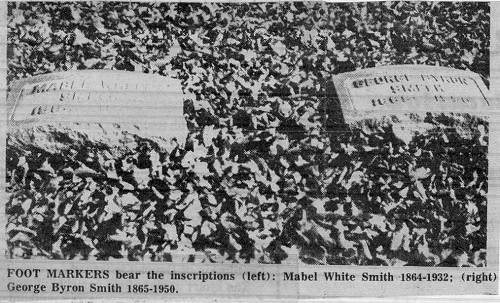
20 Grave Markers for Dr. and Mrs. Smith
Click image for larger view
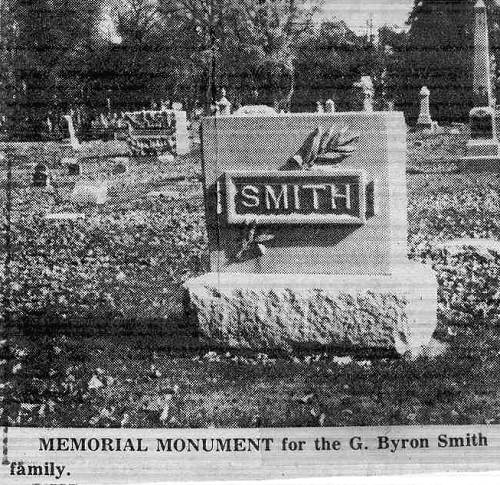
21 Memorial Marker for Smith Family
Post Script
Peggy Hake
On October 13, 1990, a celebration of the 100th anniversary of the Iberia Academy was held with many former students and teachers in attendance. More memories were made that day and it helped me to record more information for the future. I was so happy to be in attendance that day even though I had never attended the school. There was an overflow crowd of more than 250 people who were there for the Academy’s centennial year. The oldest graduate attending was Mattie Ferguson Mace, who was over 100 years old, and other early graduates included Elmer Karr, 99, and Edna Williams Irwin, 96. The former students came from near and far and represented many states across America.
Thanks Peggy for this very interesting and complete documentation of the story of Miller County’s most famous school, The Iberia Academy.
I know quite a few people who attended the Iberia academy. In my family my mother’s brother, David E. Bear attended the Junior College there in 1938. He is the first one on the left in the second row of this 1938 class photo (photo 22).
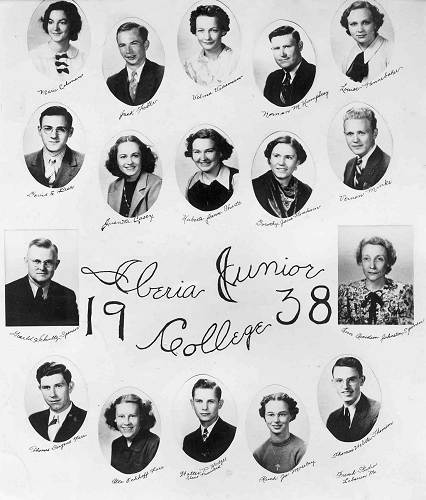
22 Iberia Academy Class of 1938
Click image for larger view
My mother’s sister, Bonnie (Bear) Tyler attended there in the late 1940’s after Professor Smith had retired (photo 23).
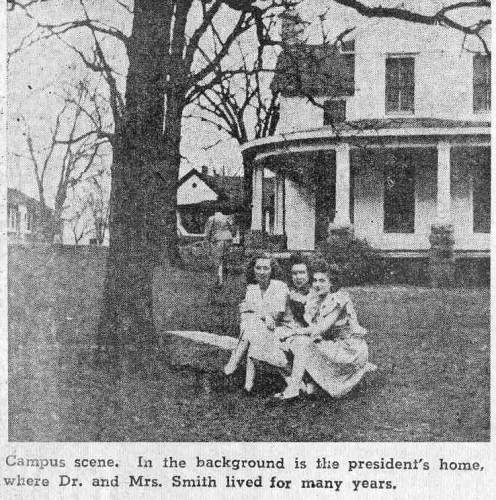
23 Juanita Morrow, Luella Condra and Bonnnie Bear in front of Smith Home
Click image for larger view
A couple of years ago I interviewed Dr. Jack Dawson, long time dentist in Eldon, now retired, who was born and raised between Ulman and Brumley (photo 24).
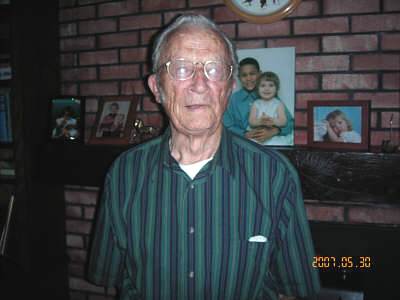
24 Jack Dawson, DDS - 2007
One of the most important influences on Jack’s life, he said, was the time he spent at the Iberia Junior College. You can read the entire interview at this URL on our web site:
http://www.millercountymuseum.org/people/bio_d.html
The following is a quote from that interview in April of 2007:
“After High school Jack attended the Iberia Junior College under the leadership of Professor George Byron Smith. Jack said he worked his way through the two years of junior college milking and caring for two cows owned by the school as well as cutting wood. Over those entire two years, his only fee owed to the school was ten dollars. He mentioned he was in school there the same time as David Bear, an uncle of mine, as well as Don Pemberton, a cousin of my wife. Jack also remembered Dean (Umstead) Dowling who recently moved back to Eldon after a long career of teaching in some of the western states. Dean, who now is ninety seven year of age, is another distant cousin of mine. Jack and I agreed that the Iberia Academy had been a very important influence on the lives of Miller County residents during its existence in the last part of the nineteenth and first half of the twentieth century. The reason for this success more than any other was because school director, Professor George Byron Smith, with the help of his wife Mabel, was so adept at directing the school. Many Miller County residents went on to other higher institutions of learning well prepared because of the efforts of Professor Smith. Jack remembered one anecdote about Professor Smith which indicated a mischievous aspect to his personality: Jack recounted that a couple of boys had been sneaking out the school horse and buggy for a ride once in a while. One night, the professor, forewarned, suspected they were about to repeat their trick so he hid in the back of the buggy under some blankets and once under way scared the daylights out of the boys as he rose up covered head to toe by the blankets to yell some unearthly epithet which quickly caused a sudden exit from the carriage by the boys as well as scared the horses such that the professor had to turn his attention to controlling them. But the boys never knew what it was that came up from nowhere behind them because they had hightailed it back to the dormitory without ever looking back.”
Parnell (“Gus”) Kallenbach M.D. (photo 24a) is another Miller Countian who benefited by his education at Iberia Academy.
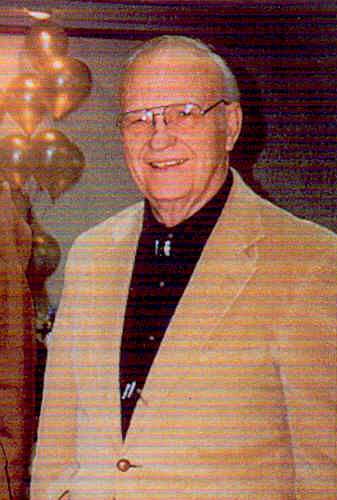
24a Parnell Kallenbach, M.D.
Dr. Kallenbach, born in 1913, is a graduate of Tuscumbia High School who went to Junior College at the Academy followed by two years at the University of Missouri Medical School when it had a two year program and finally earning his M.D. from Washington University Medical School in St. Louis. Most of his practice career occurred in Mexico, Missouri where he delivered more than 3500 babies. He is now retired. In his autobiography, a copy of which we have in the museum library (“It Can Be done: The Life and Times of Dr. Glen Parnell (Gus) Kallenbach”), he describes his experience at the Iberia Academy:
I went to Iberia Junior College and met Mr. G. Byron Smith, President of the college and the man who had started the school when he was 22 or 23 years old. He attended Knox College in Illinois, and the day after he graduated, he got married. He and his bride decided to go across country to find a place to start a school. They landed in Iberia, Missouri and started this private school. They were interested in seeing that kids who otherwise would not get an education would have a chance to get one. When I went to school, he was in his eighties, he was a very wiry, active man…he practically ran across the campus instead of walking but was still a very mellow type of person. He never seemed to cause consternation of any kind. He stayed there until the school closed. He never had anybody to take his place in the school; therefore it closed shortly after he retired.
At our first meeting Professor Smith asked me if I knew how to split wood. I said, “Yes, I do.” The he said, “We can’t get anybody here to split wood fast enough to keep the stoves going in the girls’ dormitory, so I would like you to split some wood.”
I went at it tooth and tong and by afternoon had a big pile I split the rest of the wood by sundown. Later, during an assembly, Professor Smith told the student body, “Abe Lincoln, the wood splitter is enrolled in the school here!”
They didn’t have a men’s dormitory at the school, so I had to find a place to stay. I found a room in a house just off campus, and it was just what I needed. I had a bed, a table and as I recall a pitcher with some water for the washbasin. I don’t believe I had a desk or anything else. It cost $3.50 per month for the room. I don’t remember what the tuition at the school was, but I paid $90.00 per year for meals, which we ate at the girl’s dormitory. That came to about ten cents per meal or thirty cents a day. It was permissible, if you could do it, to bring hams or canned goods from home and apply that to your tuition. I never did that…I just paid the $90.00. The meals were quite adequate. They weren’t anything to write home about, but they were good. On weekends, we usually had crackers and peanut butter and that was all.
I enjoyed one of the “seven sins” of Iberia Junior College, I had money and nobody else had any. After I taught school for three years, I had saved approximately $600-$700 dollars. A lot of kids knew that I had taught school before coming there and had some money, and when they needed a little handout; they would borrow money from me. They always paid it back. I had no problems that way. My money was in the Tuscumbia Bank!
I had some wonderful teachers at Iberia Junior College. My Science, Math and Chemistry teacher was one of the finest teachers I ever had and that would include my experience in Medical School at the University of Missouri, and Washington University. Her name was Mrs. Crawford. She was a large woman, quite a bit overweight. She had a big raspberry colored birthmark on one side of her face. It included half of her nose and all of the left side of her face, as if she had been painted with raspberry juice or something, but she was an excellent teacher. She was always in the laboratory and if I needed any help, with a problem, I could always go to her. Being a real eager beaver when I started out, I was really beginning to do well, so much so that people thought I was a genius. It didn’t take this teacher many weeks until she decided I wasn’t a genius. She put me where I belonged. I was just a hard worker. She was very good about helping me with everything. I once had a Chemistry problem that took an hour to work…truly it took an hour to go through this problem and get it right. I was able to do that. When I went to the University of Missouri, I had another Chemistry course, and at the end of the course, the teacher gave us exactly that same problem. I worked the problem, because I knew what I was doing and I was happy with what I had done before at Iberia. After the papers were graded, the Professor said, “Everybody in this class, except two people failed this problem….what’s going on here?”
Naturally, I felt very proud and had Mrs. Crawford to thank for it.
Another good teacher was Mrs. Anderson, who taught English. I don’t have anything to say, except that I think she gave us the basics in English and did a very good job at teaching. I never had the personal contact with her that I did with Mrs. Crawford; however that was because my main concern was getting my courses in Science out of the way.
I don’t recall any testing on vocabulary except the meeting I had with the people who decided I was a fit subject for Medical School. I had a German professor, whose name was Gerard Schultz. He was a very fine teacher and a very astute person. He didn’t stay at Iberia very long, because the University of Missouri picked him up. He taught German, and I took it primarily to make a grade, never thinking I would be talking to the people of Germany as I was during and after World War II. From the time I entered college, I zeroed in on the required courses that I would need to get into Medical School. At Iberia I told them what I was going to do, and they directed me to the courses I needed. I took general Chemistry, Physics, Trigonometry, Analytical Geometry and German as I stated.
I had courses in English, but I don’t remember ever having a History course. I also had a Bible course. The Congregational Church supported the school. There are not very many of them anymore, but there were quite a few of them during those days in the eastern part of the United States. During the early days they backed colleges when the States were just getting into the field of higher education.
I didn’t have a real close relationship with President Smith because he was in and out, and never taught a class that I attended; however, he did teach Latin and Greek. He didn’t have enough money to pay his teachers so he would leave the college to see benefactors about money. He would always go to William H. Danforth first and tell him that he couldn’t pay his teachers until he got some more money. William H. Danforth always told him, “You go out and get half of it somewhere else and come back and I will give you the other half.”
The President would come back with half the money and the teachers would be paid. The school had been in existence 20 or 30 years, maybe 40 years before I went there.
Two men in the faculty that had a significant influence on my future, I probably owe them more credit that I am even aware of. They were Schultz and Anderson.
I admired Gerard Schultz, the German teacher immensely. The Dean of students, Mr. Anderson was also very good to me, and helped me get through the financial problems as well as the others.
There was very little social life at Iberia. We didn’t have any parties. I was in a play one time and I worked at that pretty hard, but as far as parties, there were only a few. Gerard Schultz would have his German class down to his house where we had parties a time or two. Otherwise, there was no social life in Iberia.
At the end of the first year of Junior College, the Danforth Foundation gave me a new scholarship to go to the American Youth Foundation Camp in Shelby, Michigan, called Camp Minnewanka. I went up there as a camper for two weeks all expenses paid. The next year I returned as assistant chef and had the opportunity to work with Earl Brown, who besides being a minister, was the chief chef there too. After becoming a doctor I returned to the camp many times to be camp physician.
I left Iberia Junior Academy in 1935 after which I went to the University of Missouri in Columbia to finish my pre med studies before going to the University of Washington Medical School to earn my Medical Degree (at that time M.U. had only a two year preparatory school; one had to go to another institution for the last two years). I was well prepared for that next stage of seeking a Medical Degree.
So this ends the story about the Iberia Academy which for well over half a century was a bright and shining star of education providing many Miller County young people a head start on life and career. And to think that it would never have occurred were it not for chance and fate that Professor G. Byron Smith happened to take a certain train on a certain day long ago and just happened to talk to a “drummer” who told him about that place called “Iberia, Mizoury!”
Before finishing this week’s narrative I thought I might follow up on what has happened to the campus of the Iberia Academy since no school has been held there since 1951. The property has been bought and sold a couple or more times and I understand it is again for sale. Several of the buildings are still standing but are in disrepair. The situation of the deterioration of these once fine old buildings had been a cause of much discomfort and sorrow among many who remember the Academy when it was once a thriving educational institution under the guidance of the Smiths’. Many have hoped that someone or some business enterprise would purchase the campus and restore it. Although at times one or more of the buildings have been used for commercial enterprises none has succeeded for long. I asked Peggy Hake, author of the above history of the Academy to comment about some of the structures still present:
Joe,
This photo (photo 24b) was of the home of Professor and Mrs. Smith.
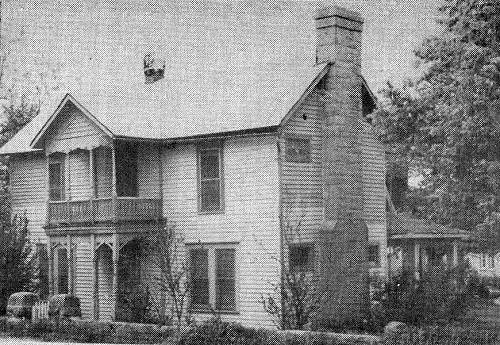
24b Iberia Academy - Home of the Smiths
The girls dormitory is sitting behind the Smith's home and is a huge 2-story building. (I believe it may have 3 floors) and is in a terrible condition---about ready to fall down and is soooo rotten! I remember when it was a fine looking old building where the girl students lived. The state highway department wants to demolish the old Smith home because of its dangerous condition, but don't know if they will do it or not. I am told the highway dept. claims part of the property is sitting on the highway right-of-way and is not legal!
The next photo (photo 25) is the girls dormitory and was
called 'Alumni Hall' for a long time.
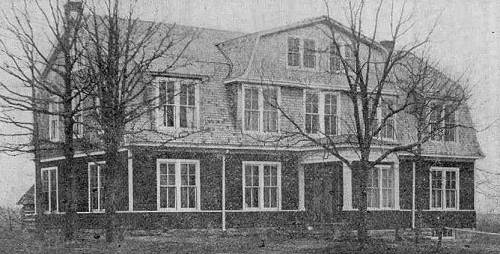
25 Alumni Hall
It is still standing today and in a horrible condition! There was another 6-room house on campus used by the girl students and it was called 'The Girls Cottage'.....I don't know if I have seen a picture of it or not. I suspect it was a house that Professor and Mrs Smith may have lived in temporarily but I am not sure of that possibility!
The next picture (photo 26) is Martin Gymnasium and it is still there also.
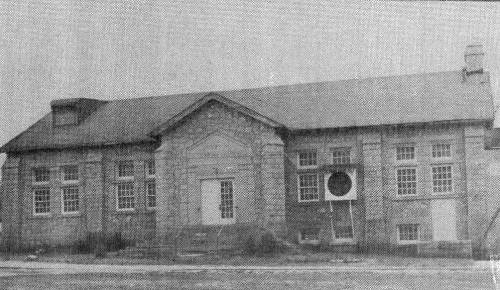
26 Martin Gymnasium
It has been used as a school gym and a factory. The owners once set up a flea market inside the building but it has deteriorated so badly, too.
The last photo (photo 27) is an old log cabin which sat on the grounds for many years and was used as a weaving cabin, laundry house, and perhaps other uses as well.
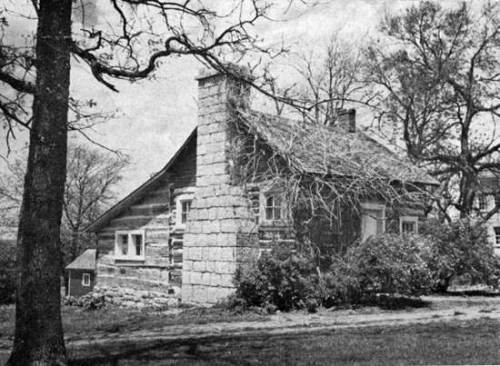
27 Ada Danforth Cabin
It was built and lived in by the Bythia Schell and her family who were an African American family. All that remains of the old log house today is the rock chimney which is attached to another house built on the same site.
Thanks Peggy.
That's all for this week.
|



